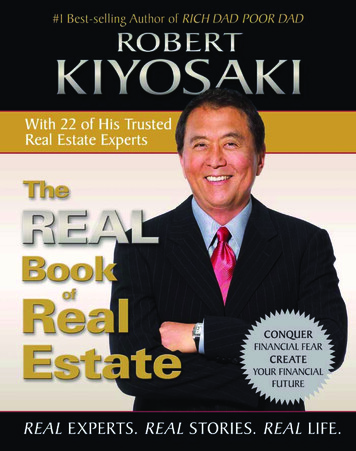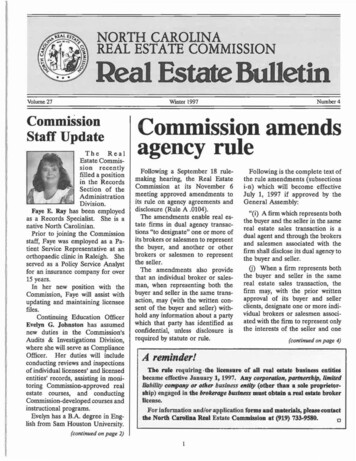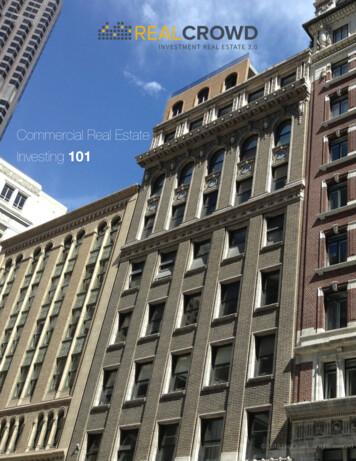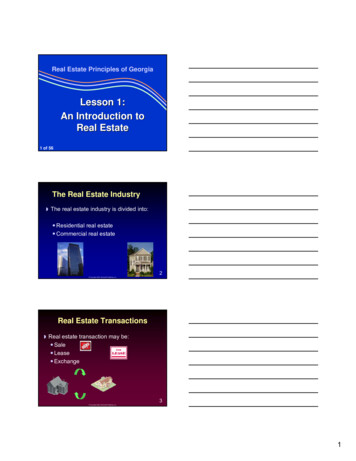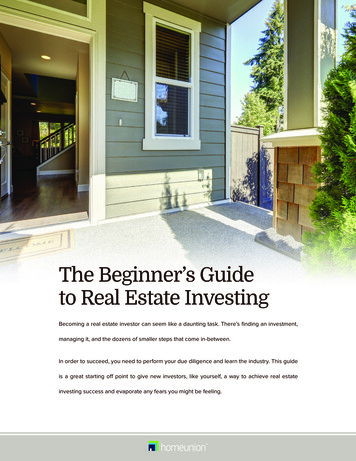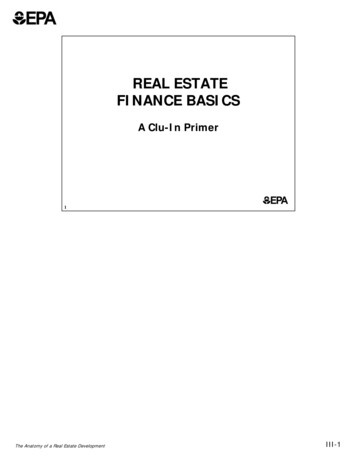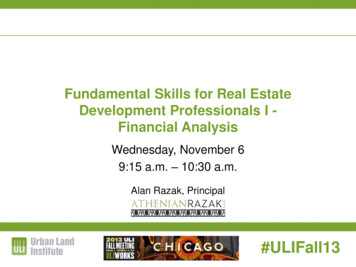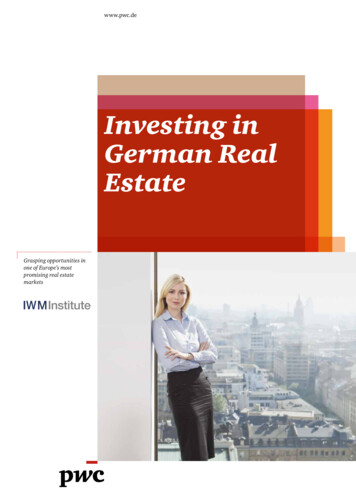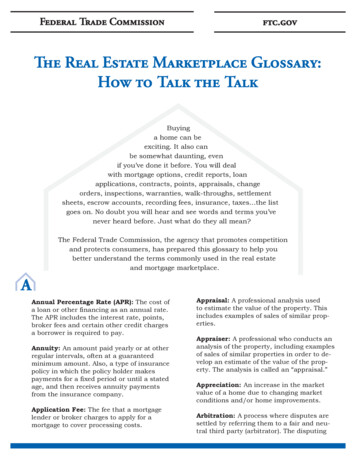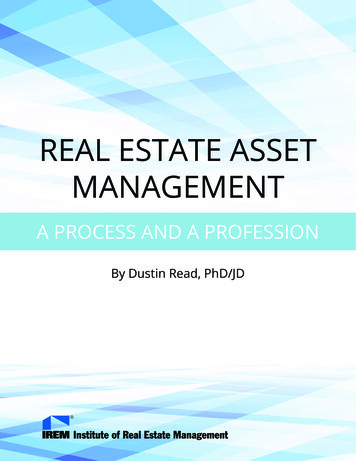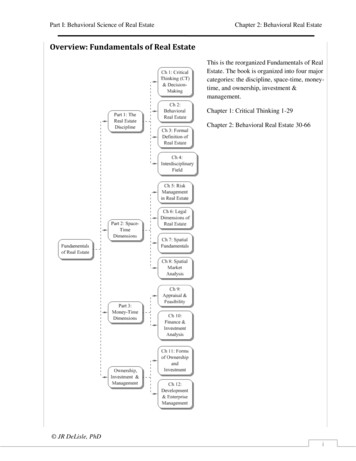
Transcription
Part I: Behavioral Science of Real EstateChapter 2: Behavioral Real EstateOverview: Fundamentals of Real EstateThis is the reorganized Fundamentals of RealEstate. The book is organized into four majorcategories: the discipline, space-time, moneytime, and ownership, investment &management.Chapter 1: Critical Thinking 1-29Chapter 2: Behavioral Real Estate 30-66 JR DeLisle, PhDi
Behavioral Real Estate TheoryTable of ContentsContentsBehavioral Nature of Real Estate .32The Real Estate Discipline .32Key Participants in Real Estate .33Key Participants in Real Estate .33Behavioral Real Estate .34Confidence Levels and Most Probable Price .34Behavioral Concepts in Real Estate .35Market Segmentation .35Market Segmentation and Market Targeting .35Requirements for Market Segmentation .36Bases for Market Segmentation .37Space User Perspective .38Employment Segmentation .39Pension Fund: Behavioral Segmentation .40Rationale Behavior .41The Notion of Involvement .41Low vs. High Involvement Decisions .41Perception.42Theories of Behavior .45Behavioral Models of Man .45Needs and Wants .46Maslow’s Needs .46Behavioralism in the Price-Setting Process .47Behavioral Price-Setting Process .47Importance of Behavioralism .47Importance of Price-Setting Process .48Dyadic Relationships and Negotiations .49Value Concepts in Dyadic Relationships .49Positioning Value Concepts .49Subjective Value to Seller .50Subjective Value to Buyer .50ii
Part I: Behavioral Science of Real EstateChapter 2: Behavioral Real EstateExhibit 2- 20 .50Bidding and Zone of Negotiation.50A Cyclical Look at Market Value vs. Investment Value .51Market Value vs. Investment Value .51The Nature of Value .51Bid-Ask Spread .52Confidence Levels and Transaction Values .52Investment Value and Owner Confidence .52Confident Owner/Buyer IVs .53Confident Owner/Buyer IVs .53Confident Owner/Uncertain Buyer .54Confident Owner/New Buyer .54Real Estate Cycles and Confidence Levels .55Cycles in Real Estate.55NCREIF Market Cycles: 1978-2010 .55Market Expectations and Real Estate Cycles .55The Role of Theory in Real Estate .56Bid-Rent Theory .57Change in Transportation Costs .57Urban CBD-Oriented Market.58Multi-Nucleated Market .58Residual Land Theory & Economic Mobility .59Vulnerable, Vulnerable, Vulnerable vs. L, L, L.59Residual Land Value Calculation .60Urban Land Economics Theory .61Linkages Among Urban Land Economics Theories .61Structure Theory, Succession Theory, and Situs Theory .61Structure Theory .62Seattle’s Market Structure and Landform .63Succession Theory .63Succession Theory .63Situs Theory .64Situs Theory Overview .64Situs Theory at a Global Level .65 JR DeLisle, PhDiii
Behavioral Real Estate TheoryIntegration of ULE Theories .65Summary Chapter 2 .66Section 3: Chapter Next .67iv
Behavioral Real Estate TheoryBlank for layout onlyThis page deliberately blank30
Chapter2: Real Estate as a Behavioral SciencePreview Chapter 1OverviewWhat you will learn in Chapter 2.This chapter introduces students to thereal estate as a behavioral science. Thisclassification comes from the uniquenature of the market in which alltransactions are negotiated. Thisunique market mechanismdistinguishes real estate from otherasset classes. At the same time, itargues for more efforts to understandhow space consumers make real estatedecisions. To add more precision, thenotion of market segmentation isintroduced as a way of identifying the“usual suspects” and focusing on themost probable buyers. How real estate differs from other asset classes. How real estate is a behavioral science. How market segmentation can be extended to real estate. How consumers approach high-involvement decisions. Behavioral models of man. The difference between needs and wants. The price-setting process. The importance of subjective values and changes over time. Bid-rent theory and gravity models. Land Residual Value Theory. Urban Land Economics TheoryExample. See example of traditional Land Residual TheoryThe chapter provides an overview ofconsumer behavior theory and thenextends that theory to the real estatemarket. It introduces the notions ofperception and perceptual biases. Itexplores high- involvement decisionsand explains how spatial consumersapproach high involvement decisions.The discussion also explores wants andneeds using Maslow’s pyramid ofneeds as a point of discussion. Toprovide an example of behavioraltheory, the impact of confidence levelson the price setting process isexplored. The discussion alsointroduces land residual theory andurban land economics theory. JR DeLisle, PhD Step 1. Income Estimation. Step 2. Rate of Return Extraction. Step 3. Value Conversion: Income/Rate. Step 4. Allocation to Factors of Production. Step 5. Residual Land ValuationKey Contructs: UrbanLand EconomicsTheorySuccessionTheory31
Behavioral Real Estate TheoryBehavioral Nature of Real EstateThe Real Estate DisciplineReal estate is a real or tangible asset in the sense that it has physicalcomponents. Real estate is also bestowed with a bundle of rights(i.e., right to enjoy, occupy, use and transfer), the scope of which isdetermined by legal/political processes that have jurisdiction over it.From a professional perspective, the real estate discipline is anumbrella field, spanning a number of disciplines that focus onvarious elements of the real estate process. From an academicperspective, real estate is an area of practice that is taught at theuniversity level and is the subject of research and publicationactivities by faculty members. In an applied sense, the field draws ona broad array of ancillary disciplines including appraisal, brokerage,construction, development, finance, investment, management andtransactions. Thus, when looked at from an aggregate perspective,real estate is an interdisciplinary field of inquiry.the real estatediscipline isfundamentally differentfrom other businessdisciplines in the sensethat the market isinefficient and as such,must be approached asa behavioral science.Most other disciplines that are built around physical assets can refer to the natural or physical sciences fora theoretical foundation. This is not the case in real estate which is a hybrid area comprised of bo
Real estate is a real or tangible asset in the sense that it has physical components. Real estate is also bestowed with a bundle of rights (i.e., right to enjoy, occupy, use and transfer), the scope of which is determined by legal/political processes that have jurisdiction over it. From a professional perspective, the real estate discipline is an umbrella field, spanning a number of .
